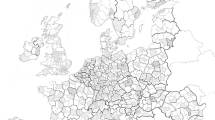Abstract
Politicians bias public policies to favor particular election districts. According to the traditional common pool model, districts facing low tax shares should receive relatively large government projects. We suggest a swing-voter model where the number of voters on the ideological cut point, lack of party identification and number of district representatives per voter determine project sizes. We analyze the allocation of state road investments in Norway from 1973–1997 exploiting unique data on characteristics of voters, legislative representation and tax prices in 19 election districts. Geographical representation to parliament is biased, mostly due to an ancient constitution. Shares of swing voters and legislative over-representation lead to higher levels of road investments, while high levels of party identification reduce investments.
Similar content being viewed by others
References
Ansolabere, S., Gerber, A., & Snyder, J. (2002). Eequal votes, equal money: court-ordered redistricting and the distribution of public expenditures in the American states. American Political Science Review, 96, 767–777.
Atlas, C., Gilligan, T., Hendershott, R., & Zupan, M. (1995). Slicing the federal governments net spending pie: who wins, who loses, and why. American Economic Review, 85, 624–629.
Baron, D. (1993). A theory of collective choice for government programs. Research Paper 1240, Stanford Business School.
Baron, D., & Ferejohn, J. (1989). Bargaining in Legislatures. American Political Science Review, 83(4), 1181–1206.
Baqir, R. (2002). Districting and government overspending. Journal of Political Economy, 110, 1318–1354.
Borge, L., & Rattsø, J. (1997). Local government grants and income tax revenue: redistributive politics in Norway 1900–1990. Public Choice, 92, 181–197.
Borge, L., & Rattsø, J. (2002). Spending growth with vertical fiscal imbalance: decentralized government spending in Norway, 1880–1990. Economics and Politics, 14, 351–373.
Case, A. (2001). Election goals and income redistribution: Recent evidence from Albania. European Economic Review, 45, 405–423.
Chari, V., & Cole, H. (1995). A contribution to the theory of pork barrel spending (Mimeo). Federal Reserve Bank of Minneapolis.
Cox, G., & McCubbins, M. (1986). Electoral politics as a redistributive game. The Journal of Politics, 48(2), 370–389.
Dahlberg, M., & Johansson, E. (2002). On the purchasing behavior of incumbent governments. American Political Science Review, 96(1), 27–40.
Del Rossi, A. (1995). The politics of pork barrel spending: The case of federal financing of water resources development. Public Choice, 85, 285–305.
Del Rossi, A., & Inman, R. (1999). Changing the price of pork: the impact of local cost sharing on legislators’ demands for distributive public goods. Journal of Public Economics, 71(2), 247–273.
Dixit, A., & Londregan, J. (1996). The determinants of success of special interests in redistributive politics. The Journal of Politics, 58(4), 1132–1155.
Drazen, A. (2000). Political economy in macroeconomics. Princeton: Princeton University Press.
Elvik, R. (1995). Explaining the distribution of funds for national road investments between counties in Norway: engineering standards or vote trading? Public Choice, 85, 371–388.
Gilligan, T., & Matsusaka, J. (1995). Deviations from constituent interests: the role of legislative structure and political parties in the states. Economic Inquiry, 33(3), 383–401.
Gilligan, T., & Matsusaka, J. (2001). Fiscal policy, legislature size, and political parties: evidence from state and local governments in the first half of the 20th century. National Tax Journal, 54(1), 57–82.
Hird, J. (1991). The political economy of pork: project selection at the US army corps of engineers. American Political Science Review, 85, 429–456.
Horiuchi, Y., & Saito, J. (2003). Reapportionment and redistribution: consequences of electoral reform in Japan. American Journal of Political Science, 47, 669–682.
Inman, R., & Fitts, M. (1990). Political institutions and fiscal policy: evidence from the US historical record. Journal of Law, Economics, and Organization, 6, 79–132.
Johansson, E. (2003). Intergovernmental grants as a tactical instrument: empirical evidence from Swedish municipalities. Journal of Public Economics, 87, 883–915.
Lee, F. (1998). Representation and public policy: the consequences of senate apportionment for the geographic distribution of federal funds. Journal of Politics, 60, 34–62.
Lindbeck, A., & Weibull, J. (1987). Balanced-budget redistribution as the outcome of political competition. Public Choice, 52, 273–297.
McCubbins, M., & Schwartz, T. (1988). Congress, the courts, and public policy: consequences of the one man, one vote rule. American Journal of Political Science, 32, 388–415.
Persson, T., & Tabellini, G. (2000). Political economics: explaining economic policy. Cambridge, MA: MIT Press.
Strömberg, D. (1998). Radio’s impact on public spending (Mimeo). Stockholm, Institute for International Economic Studies.
Weingast, B. (1979). A rational choice perspective on congressional norms. American Journal of Political Science, 23, 245–262.
Weingast, B., Shepsle, K., & Johnson, C. (1981). The political economy of benefits and costs: a neoclassical approach to distributive politics. Journal of Political Economy, 89, 642–664.
Wittman, D. (1995). The myth of democratic failure: why political institutions are efficient. Chicago: Chicago University Press.
Wright, G. (1974). The political economy of New Deal spending: an econometric analysis. The Review of Economics and Statistics, 56, 30–38.
Author information
Authors and Affiliations
Corresponding author
Rights and permissions
About this article
Cite this article
Helland, L., Sørensen, R.J. Geographical redistribution with disproportional representation: a politico-economic model of Norwegian road projects. Public Choice 139, 5–19 (2009). https://doi.org/10.1007/s11127-008-9373-z
Received:
Accepted:
Published:
Issue Date:
DOI: https://doi.org/10.1007/s11127-008-9373-z




